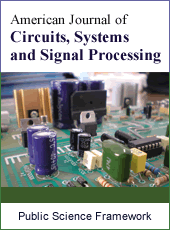American Journal of Circuits, Systems and Signal Processing
Articles Information
American Journal of Circuits, Systems and Signal Processing, Vol.1, No.2, Jun. 2015, Pub. Date: Jun. 17, 2015
Communication Systems Noise Reduction Based on Adaptive Spectral Subtraction Method
Pages: 47-55 Views: 3644 Downloads: 2525
[01]
Isiaka A. Alimi, Department of Electrical and Electronics Engineering, School of Engineering and Engineering Technology, Federal University of Technology, Akure, Nigeria.
[02]
Tusin D. Ebinowen, Department of Electrical and Electronics Engineering, School of Engineering and Engineering Technology, Federal University of Technology, Akure, Nigeria.
The spectral subtraction (SS) method is a well-known signal enhancement technique that reduces the effect of noise in a noisy signal in order to improve the signal quality. The SS works on the principle that noise spectrum estimate over the entire speech spectrum can be subtracted from the noisy signal. However, noise does not affect the speech signal uniformly over the entire spectrum at different frequency bands. Therefore, most implementations of the basic technique lead to anomaly known as “musical” tones artifacts in the enhanced signal. The abnormality can then be perceived as residual noise and speech distortion in the resulting signal. In this paper, we propose a multi-band spectral subtraction (MBSS) method using novel noise element suppression (NES). The proposed scheme gives comparatively better performance and the computation required is minimal. Furthermore, simulation results show that the proposed algorithm removes noise without removing the relatively low amplitude signal over the entire speech spectrum.
Speech Enhancement, Musical Noise, Spectral Subtraction, Noise Element Suppression, Multi-Band, Sub-Band
[01]
F. Jabloun and B. Champagne, “Incorporating the human hearing properties in the signal subspace approach for speech enhancement”, IEEE Trans. Speech Audio Process., vol. 11, no. 6, pp. 700–708. 2003.
[02]
D. Burshtein and S. Gannot, “Speech enhancement using a mixture-maximum model”, IEEE Trans. Speech Audio Process., vol. 10, no. 6, pp. 341–351, 2002.
[03]
S. F. Boll, “Suppression of acoustic noise in speech using spectral subtraction”, IEEE Trans. Acoustics, vol. 27, no. 2, pp. 113–120, 1979.
[04]
S. Doclo and M. Moonen, “GSVD-based optimal filtering for single and multi-microphone speech enhancement”, IEEE Trans. Sig. Process., vol. 50, no. 9, pp. 2230–2244, 2002.
[05]
C. Zhixin, “Simulation of Spectral Subtraction Based Noise Reduction Method,” International Journal of Advanced Computer Science and Applications, vol. 2, no.8, pp. 30-32, 2011.
[06]
G. Prabhakaran,; J. Indra and N. Kasthuri, “Tamil speech enhancement using non-linear spectral subtraction,” 2014 International Conference on Communications and Signal Processing pp.1482-1485, 2014.
[07]
D. E. Tsoukalas, J. N. Mourjopoulos, and G. Kokkinakis, “Speech Enhancement based on Audible Noise Suppression”, IEEE Trans. Speech Audio Process., vol. 5, no. 6, pp. 497–514, 1997.
[08]
Y. Uemura, Y. Takahashi, H. Saruwatari, K. Shikano, and K. Kondo, “Musical noise generation analysis for noise reduction methods based on spectral subtraction and MMSE STSA estimatio,” in Proceedings of the International Conference on Acoustics, Speech, and Signal Processing (ICASSP ’09), pp. 4433–4436, 2009.
[09]
T. Inoue, H. Saruwatari, Yu Takahashi, K. Shikano, and K. Kondo “Theoretical Analysis of Musical Noise in Generalized Spectral Subtraction Based on Higher Order Statistics,” IEEE Transactions on Audio, Speech, and Language Processing, vol. 19, no. 6, pp. 1770-1779, 2011.
[10]
I. A. Alimi and M. O. Kolawole, “Enhancement of Speech Communication Technology Performance a Using Adaptive-Control Factor Based Spectral Subtraction Method,” Journal of Telecommunication and Information Technology. vol.2, pp. 35-39, 2013.

ISSN Print: 2381-7194
ISSN Online: 2381-7208
Current Issue:
Vol. 6, Issue 1, March Submit a Manuscript Join Editorial Board Join Reviewer Team
ISSN Online: 2381-7208
Current Issue:
Vol. 6, Issue 1, March Submit a Manuscript Join Editorial Board Join Reviewer Team
| About This Journal |
| All Issues |
| Open Access |
| Indexing |
| Payment Information |
| Author Guidelines |
| Review Process |
| Publication Ethics |
| Editorial Board |
| Peer Reviewers |


